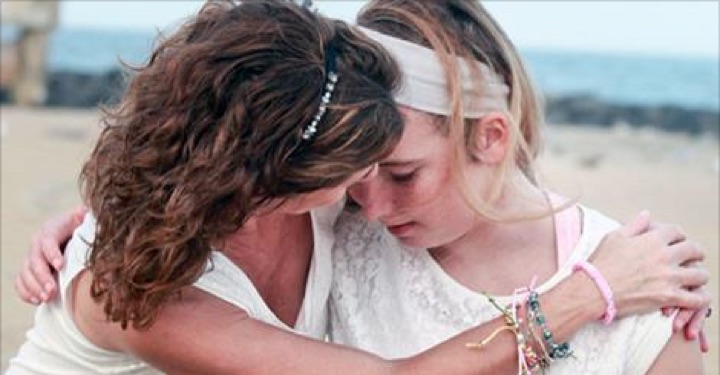
Susan Funck got the horrible news on her 47th birthday – Aug. 27, 2012.
Her 13-year-old daughter, Hannah Duffy, had a brain tumor. A biopsy later confirmed that the tumor was malignant. It would be fatal.
Funck swore from the beginning that she would tell Hannah the whole truth about her diagnosis. Over the next year, Hannah confronted her mortality, sometimes tearfully. She also scored a winning soccer goal in double overtime two weeks after her biopsy. She laughed and celebrated. She demanded spicy food on chemo days. She kept her heart open.
During an emotional hour in a small Convention Center meeting room, Hannah’s mother, along with her oncologist and chaplain, described what Hannah feared and wanted as her cancer progressed.
While it’s her “mission” to be open with the children she treats, Jean Belasco, the oncologist, said the path that Hannah and her family chose was unusual and a “work in progress.”
Laura Palmer, the chaplain, said Hannah’s story showed the value of hard conversations, a recurring theme at the four-day meeting of nearly 3,000 health professionals. The author and surgeon Atul Gawande had addressed the main gathering a short time before.
“Until we ask someone what their fears and concerns are about dying,” she said, “we really cannot know what they are thinking.”
Hannah’s mother spoke of her as a natural athlete, a loyal friend, and an adoring big sister.
Funck and her ex-husband, Kevin, decided that Belasco would break the news to Hannah that the MRI had found a tumor. Her mother would be present.
“I looked at her and only her, and said she had a brain tumor,” the oncologist said.
“Is it benign or malignant?” Hannah immediately asked.
“I don’t know,” Belasco replied. That and a little information about the biopsy was all that the girl needed then.
Hannah, who had been having seizures that summer, had suspected a brain tumor. “It wasn’t a surprise to me,” she wrote in her journal after the MRI. “It was like I expected it.”
After “nine really good months,” her mother said, Hannah was hospitalized again.
Belasco told her the cancer was back.
“Well, it never went away,” Hannah said.
“Am I going to die?” she asked.
“Yes,” Belasco answered, “but not today.”
Then Palmer stepped in. She talked with Funck about Hannah’s upbringing – Catholic – and met her new, very sick patient in a dark hospital room. Funck lay in bed with her daughter. The three talked for a long, painful time. They all cried.
“Will everyone forget me when I die?” Hannah asked.
Palmer said Hannah had made such a big impact on her family and friends that her spirit would live on. “No one could possibly forget her,” she said, “because, when you love someone deeply, you live in that love forever and, unless you stop loving someone, you can’t forget them.”
Hannah asked if it would hurt to die or be cremated – no – and if she would be able to recognize her Aunt Michele when she got to heaven. Palmer said Aunt Michele would recognize her. She said Hannah would be able to recognize her mother even if Funck died 50 years later. “You know the sound of each other’s heartbeats,” Palmer said.
“Will people be disappointed in me?” Hannah asked. “I was supposed to beat my cancer.”
Hannah had beaten the cancer by not letting it touch her spirit, Palmer said. She had inspired others by not letting fear hold her back, by living life on her terms.
Hours later, the chaplain was still shaken. Then she saw a surprisingly happy Funck in the hall and learned that Hannah felt much better. “What I thought might be too much was cathartic and liberating for Hannah,” Palmer realized.
Soon after, Hannah asked to go home. Her doctor was pleased. It meant Hannah had taken control of her life. Hundreds of people from her community, Tinton Falls, N.J., welcomed her home. She lived, with help from hospice, for five more weeks.
She gave marching orders to her survivors.
Her close friends were to wear pink high heels with shiny silver H’s etched in glitter on the soles to her wake. (They used rhinestone stickers.) She asked friends to embroider her name on their wedding dresses. She said she would send signs for them after her death: sunbeams and butterflies.
“When you look at a clock and you see that it’s 9:11, think that it’s me,” she told her mother.
Why 9:11? Funck asked. “Every time I look at the clock, it’s 9:11,” Hannah told her.
On Hannah’s last day, her room seemed peaceful and glowing.
“You can fly with the angels,” her mother told her. “Mommy will be OK.”
Hannah died on Sept. 26, 2013, at 9:11 p.m.
She was 14.
After the presentation Friday, Funck said Hannah would have wanted the hospice doctors and nurses to hear about her life.
“Her greatest fear was that she was terrified of being forgotten,” her mother said. “I think it’s important, as hard as it is for me, to share her story.”
Hannah’s biggest fear was of “being forgotten.” Let’s make sure her spirit and her remarkable story live on. Let’s help provide inspiration for others, especially those facing similar situations. Share this story, or your own, with your friends and peers. Starting the conversation could mean more to them than you think.

